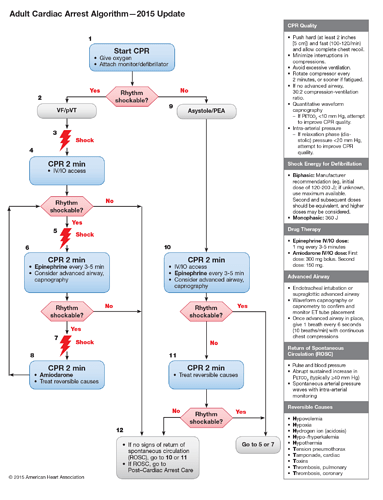We have received some questions concerning how Pulse can support cardiac arrest scenarios. I will attempt to give a succinct explanation of how heart rhythms, cardiac arrest, and CPR currently work. More details can be found in the cardiovascular system documentation.
Heart Rhythms:
Currently, Pulse only supports two rhythms: Normal Sinus (including Sinus Tachycardia and Sinus Bradycardia) and Asystole. Planned future expansions include adding Ventricular Fibrillation and Pulseless Ventricular Tachycardia. These models would likely affect the elastance driver waveform for the heart. New heart rhythms would require new ECG waveforms.
ECG:
We do not currently model the electrical activity of the heart. The ECG waveform is canned data that is shifted temporarily based on the heart rate. We provide a lead 3 waveform. We designed the ECG output to make it easy to add new waveforms for different leads by adding electric potential vs. time data to a protobuf file similar to StandardECG.pba.
Cardiac Arrest:
We model idiopathic sudden cardiac arrest, where the heart and breathing will abruptly stop. Cardiac arrest occurs in the engine when the CardiacArrest action is applied or when the patient’s heart rate drops below 27 bpm. It will cause the heart rhythm to switch to Asystole. Recovery from cardiac arrest is currently impossible in the engine. We have plans to refactor the entire heart rhythm logic while simultaneously adding the ability to reverse cardiac arrest. This will allow for the addition of Advanced Cardiac Life Support (ACLS) scenarios where some recovery of the patient is actually possible. For example, we would like to allow for simulations that allow learners to follow this algorithm:
CPR:
CPR can be applied to patients in a state of cardiac arrest by using either the ChestCompressionForce or ChestCompressionForceScale action. If implemented properly, CPR will maintain some perfusion through the induced hemodynamic action.
Defibrillation:
We do not currently model defibrillation. To model defibrillation, shockable rhythms (i.e., Ventricular Fibrillation and Pulseless Ventricular Tachycardia) should be added to the engine with the ability to switch to Ventricular Asystole or Pulseless Electrical Activity. While this could be simulated without adding a model for electrical activity of the heart, it would ideally include a new full electrical model.
